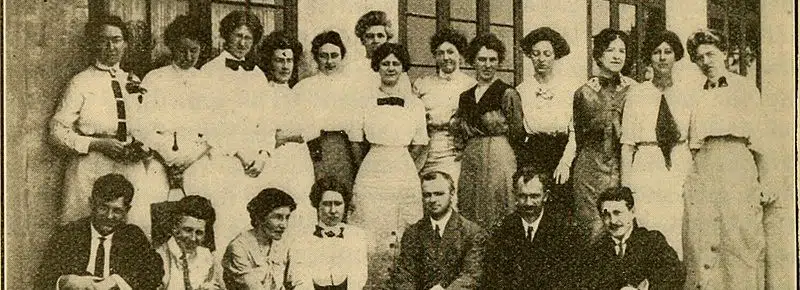Fear and a lack of understanding often cause people to do unthinkable things. The advent of eugenic sterilization in twentieth-century America is one example.
Let’s take a step back to the 1880s and briefly meet Sir Francis Galton. Galton was an anthropologist, a sociologist, and a psychologist. He was also a eugenicist. Eugenics is the “advocacy of controlled selective breeding” to ensure the superiority of a certain race. Galton studied Britain’s upper classes and determined that their social positions were a direct result of a “superior genetic makeup.”
His teachings spread to the burgeoning American nation—a nation often fraught with fear of immigrants and people of different colors, races, or abilities. This led to the attempt to keep certain people from procreating.

In 1897, Michigan introduced a compulsory sterilization bill that “called for the castration of certain types of criminals and ‘degenerates.’” However, it lacked votes and was never adopted.
In 1905, state legislators in Pennsylvania passed the Act for the Prevention of Idiocy. This bill called for the compulsory sterilization of people in state institutions who were deemed “idiots” or “imbeciles.” The governor felt this was cruel and vetoed it.
Then, in 1907, Indiana passed a law making it the first to enact eugenic sterilization legislation. This law targeted “confirmed criminals,” “imbeciles,” “idiots,” and “rapists” who were confined to state institutions.
Two years later, California and Washington followed suit. California targeted patients in state hospitals and institutions for the “mentally retarded,” as well as prison inmates, while Washington targeted habitual criminals and men convicted of rape.
As these eugenic ideas spread, foundations such as the Carnegie Institution and the Rockefeller Foundation began funding research. In 1911, the Eugenics Record Office was established in Cold Spring Harbor, New York. The ERO began collecting data on families. It concluded that the people it deemed “unfit” came from socially and economically poor families. The answer was sterilization.
Harry Laughlin’s Model for Eugenic Sterilization
The assistant director and superintendent of the Eugenics Record Office was a man named Harry Laughlin. Laughlin published numerous articles and books on eugenics, eugenic sterilization, genetics, and immigration. And in 1914, he published his Model Eugenical Sterilization Law. This law proposed the sterilization of people deemed “socially inadequate.” Included under this umbrella term were people residing in institutions, those who required the government’s financial assistance, and the “feebleminded, insane, criminalistic, epileptic, inebriate, diseased, blind, deaf, deformed, and dependent.” He also included “orphans, ne’er-do-wells, tramps, the homeless and paupers.”
Laughlin believed that the people who should be subjected to the compulsory sterilization laws were those who were socially inadequate and who posed a threat to the population. In 1922, he published his Model Sterilization Law in his book Eugenical Sterilization in the United States. He claimed that, if the law were enacted, “the genes from ‘the most worthless one-tenth of our present population’ would be eliminated within two generations.”
Eugenical Sterilization in the United States established Laughlin as an expert on eugenics. He printed only a few thousand copies and distributed them mainly to men in government offices. The purpose was to influence state legislatures to create and implement their own eugenic laws. The ideas espoused in his book struck a chord with these men, resulting in his model being used by many of the states that passed eugenic sterilization laws.
Laughlin also sent a copy of his book to bureaucrats in Germany. They liked his ideas so much that they modeled their eugenic sterilization laws after his, in 1933, passing the Law for the Prevention of Hereditarily Diseased Offspring. And “under this law, the Nazis sterilized approximately 400,000 children and adults, mostly Jews and other ‘undesirables,’ labeled ‘defective.’” In 1936, the Germans invited Laughlin to an award ceremony at Heidelberg University, where he was scheduled to receive an honorary doctorate for his work on the “science of racial cleansing.”
As eugenics gained ground in state legislatures, it also found its way into academia. By 1928, there were almost 400 courses on eugenics taught in some of the nation’s leading universities. This idea that only the elite should prosper and propagate caught the attention of feminist organizations such as the National League of Women Voters, the National Federation of Women’s Clubs, and the Woman’s Christian Temperance Union. And, of course, one of the most well-known feminists to jump on the bandwagon was Margaret Sanger, who saw those in lower classes as unfit and feebleminded.
Once people in leadership positions began to believe that the lower classes should not have children, they began to enact laws to keep them from having children.
According to a site examining eugenics in the US:
Both class and race factored into eugenic definitions of “fit” and “unfit.” By using intelligence testing, American eugenicists asserted that social mobility was indicative of one’s genetic fitness. This reaffirmed the existing class and racial hierarchies and explained why the upper-to-middle class was predominantly white. Middle-to-upper class status was a marker of “superior strains.” In contrast, eugenicists believed poverty to be a characteristic of genetic inferiority, which meant that that those deemed “unfit” were predominantly of the lower classes.
NPR explains:
“Feebleminded” was really the craze in American eugenics. There was this idea that we were being drowned in a tide of feeblemindedness—that basically unintelligent people were taking over, reproducing more quickly than the intelligent people—but it was also a very malleable term that was used to define large categories of people that, again, were disliked by someone who was in the decision-making position. So, women who were thought to be overly interested in sex, licentious, were sometimes deemed feebleminded. It was a broad category and it was very hard to prove at one of these feeblemindedness hearings that you were not feebleminded.
By 1930, 30 states had passed laws that mandated eugenic sterilization for various moral or criminal offenses. Almost all of these states “imposed mandatory sterilization of mentally defective citizens. Nineteen states required sterilization for parents of children likely to experience various disorders. Six states encouraged sterilization for individuals whose children might be ‘socially inadequate.’”
Buck v. Bell
Laughlin’s Eugenical Sterilization in the United States inspired many state laws. One of these was the Virginia Sterilization Act of 1924. This law allowed the compulsory sterilization of the mentally disabled in Virginia. It stated that, in certain cases, “inmates of any state institution could be sterilized if the institution’s board found that the patient was idiotic, insane, feebleminded, epileptic, or an imbecile.”
E. Lee Trinkle, the governor of Virginia at the time, “advocated the sterilization bill as a cost-saving strategy for public institutions that had experienced growth in the incarceration of what he referred to as feebleminded and defective populations. Trinkle added that legalizing sterilization for the insane, epileptic, and feeble-minded persons would allow these patients to leave the institutions and not propagate their own kind.”
The language of the bill never mentioned eugenics. It attempted to highlight the fact that Virginia was losing money because there were too many people in its institutions. It claimed that the sterilization of people would help the economy.
The law was eventually challenged and went all the way to the Supreme Court, which upheld it in 1927 in the case of Buck v. Bell. The Supreme Court said that the compulsory sterilization of people in mental health facilities didn’t violate the due process clause of the Fourteenth Amendment and that states had the right to sterilize.

Who challenged Virginia’s sterilization law?
Carrie Buck was a 17-year-old pregnant mother living in the foster care system. Her mother, Emma, was already a resident in a Virginia home for the mentally disabled. Emma
was in poor health, having suffered from rheumatism, pneumonia, and syphilis. Her record indicated that she was arrested for prostitution and giving birth to illegitimate children, while scars on her arms hinted at previous drug use. Despite these claims, Emma Buck was married to Carrie’s father, Frank Buck, and every time she entered a hospital to deliver a child, she was designated as married. Like her daughter, Emma Buck was admitted to the Colony on the basis that she was “feebleminded” within the meaning of the law.
Carrie’s foster family said she was unruly and promiscuous and that they could not control her. They sent her to the same Virginia institute as her mother. However, it was not promiscuous behavior that got Carrie pregnant, but rape. Her foster mother’s nephew raped and impregnated her. When the baby, Vivian, was born, she was taken from Carrie and eventually placed with the same foster family Carrie lived with.
The administrators of the home needed someone to test the case for compulsory sterilization. Carrie fit the bill. As Emma and Carrie were now both institutionalized, it was not difficult to prove in court that they were “feebleminded.” However, they had to prove that Baby Vivian was also feebleminded.
A social worker visited the baby several times. At first, she said she could find nothing wrong. But then she finally stated that Vivian was “not quite a normal baby.” This was enough for the court to decide.
In an eight-to-one decision, the Supreme Court ordered that Carrie be sterilized. Oliver Wendell Holmes Jr. wrote the majority opinion. He said, in part: “Instead of waiting to execute degenerate offspring for crime, or to let them starve for their imbecility, society can prevent those who are manifestly unfit from continuing their kind…. Three generations of imbeciles are enough.”
Buck v. Bell set the precedent that states could legally sterilize inmates of public institutions. The court argued that imbecility, epilepsy, and feeblemindedness are hereditary. Further, it argued that inmates should be prevented from passing these defects to the next generation. Buck v. Bell determined that compulsory eugenic sterilization laws did not violate the due process clause of the 14th Amendment.
Historian Paul Lombardo conducted extensive research into Carrie Buck’s family, eventually writing a book entitled Three Generations, No Imbeciles. He concluded that neither Vivian nor Carrie had mental deficiencies. Report cards indicated that they earned average grades in school. Little Vivian even made the honor roll one term. She died from an infection at the age of eight, however, so no further data is available.
Virginia repealed its Sterilization Act in 1974. Yet Buck v. Bell has never been overturned.
Skinner v. State of Oklahoma
In 1942, the US Supreme Court heard the case of Skinner v. State of Oklahoma. This particular case dealt with inmates in the state prison system. Oklahoma wanted to sterilize inmates who had had two or more convictions for non-white-collar crimes. Jack Skinner was an inmate at Oklahoma State Penitentiary. He had been convicted of two separate counts of armed robbery and of stealing chickens. Under the Oklahoma Habitual Criminal Sterilization Act of 1935, Skinner was subject to sterilization. This act “mandated that the state order and perform sterilizations on people who had been convicted of crimes two or more times in Oklahoma or any other state, and who were incarcerated in Oklahoma. However, there were exceptions to the law, including those convicted of crimes such as embezzlement, the violation of prohibitory laws or revenue acts, and political wrongdoings.”
The Supreme Court ruled that involuntary sterilization of certain inmates violated the equal protection clause of the 14th Amendment. They said the prison system could not differentiate between offenders when it came to sterilization. They could not have one mandate for those who committed white-collar crimes and another for other crimes.
However, this ruling did not affect those living in state-run mental health facilities. So compulsory eugenic sterilization continued for three more decades.
Laws in Other States
Over 30 states had laws allowing for the eugenic sterilization of people deemed “unfit” or “defective” in some way. Most made judgments based on fear of what might happen. And all devalued the person.
In 1917, the Oregon State legislature passed a bill entitled “To Prevent Procreation of Certain Classes in Oregon.” It then created the Oregon State Board of Eugenics. From 1917 to 1981, over 2,600 residents were forcefully sterilized. These included prison inmates, orphans, patients in mental institutions, and other people who were wards of the state. The reasoning behind their sterilization was to keep them from adding their “defective” genes into the gene pool.
North Carolina sterilized 7,600 people between the years of 1929 and 1973. Women, especially black women, vastly outnumbered the men. According to records, black women “were sterilized at more than three times the rate of white women and more than 12 times the rate of white men.”
Michigan had approximately 3,786 officially documented cases of eugenic sterilization. About three-quarters of them were on females. Records show that “440 sterilizations cases were carried out on people considered mentally ill, while 2927 were carried out on persons deemed mentally deficient. The remaining 419 were of neither—those considered ‘sexual deviants, epileptics or moral degenerates.’”
In the state of Washington, the people targeted for eugenic sterilization were those deemed socially degenerate. These included “reform-school girls, welfare moms, the retarded, gays, and the physically disabled…. Many homosexuals who faced imprisonment also faced sterilization under the 1909 law…. [And] Washington ‘heartily embraced the association between illegitimacy, mental incompetence, and poverty among black women.’”
California ranked number one in eugenic sterilization. In total, the state sterilized 20,108 people prior to 1964, with the numbers of men and women about equal. According to records, “almost 60% were considered mentally ill and more than 35% were considered mentally deficient.” However, the sterilizations did not stop then. Between 1997 and 2013, unwanted sterilizations were performed on approximately 1,400 women in California prisons before investigations into the practice finally put an end to it.
Minnesota sterilized 2,350 people. Almost 80% were female. According to records, “about 18% were deemed mentally ill and 82% mentally deficient…. ‘Defective’ individuals included the feeble-minded and insane persons that were hospitalized. Most of the sterilizations were of poor, sexually active women who violated the traditional standards of morality and allegedly had children who they could not support.”
In Kansas, just over 3,000 people were sterilized, with about 60% being male. According to records, “The 1913 legislation was directed at ‘habitual criminals, idiots, epileptics, imbeciles, and insane.’”
Restitution
In 2002, the governor of North Carolina formally apologized for the state’s role in the forcible sterilization of its residents. Then in 2013, the state compensated over 200 victims, each receiving approximately $20,000.
Two years later, Virginia also compensated its residents, awarding about $25,000 to each.
In 1981, Oregon ordered its last forced eugenic sterilization. The governor issued a formal apology in 2002.
Eugenics Lives on Today
Though forcible eugenic sterilization is mostly a thing of the past and a dark spot in our country’s history, we often see that eugenic mentality today.
We see it in genetic engineering research with the manipulation of embryos. We see it in genetic enhancements. We see it in sex-selection abortion. We see it in embryos created through IVF who are selected for sex and genetic strength. And we see it in the pro-abortion movement. Organizations like Planned Parenthood target minorities. Almost 80% of PP’s clinics are in black and Latino neighborhoods.
We have become a country of people who wrongly believe that people who aren’t genetically perfect are burdens.
Fear of the unknown, fear of the those who may have disabilities, and fear of those who are different often cripple people.
But the Church teaches the sanctity of all human beings, regardless of ability, race, or color. And it teaches the sanctity of the human body.
The Catholic Church and Sterilization
In Humanae Vitae, Pope Paul VI condemns both abortion and sterilization, saying: “Equally to be condemned, as the magisterium of the Church has affirmed on many occasions, is direct sterilization, whether of the man or of the woman, whether permanent or temporary.”
Sterilization reduces the human body to a commodity. It allows the body to become something used just for pleasure. This is not what God intended.
HLI’s Brian Clowes says it beautifully:
The Catholic Church considers the body to be the temple of the Holy Spirit…and thus it should be honored, protected, and preserved. This means that any mutilation of the body—including extreme “body modifications,” so-called “sex-change operations,” and attempts to cripple it for social reasons (including sterilization)—is to be condemned. Such mutilations “violate the integrity of the human person.” Direct sterilization destroys the normal and proper functioning of a body system and is thus illicit in all cases.
Our bodies are temples of the Holy Spirit. We must care for ourselves and any children with love and compassion. Each and every person has dignity and value. Our treatment of them must reflect that dignity.
Fear and a lack of understanding are not excuses for mutilating bodies. Nor are they excuses for targeting people of different races or different abilities.
Let us pray that this knowledge of the past leads to an understanding of it. If not, we are doomed to repeat it.
Related Content
Susan Ciancio has a BA in psychology and a BA in sociology from the University of Notre Dame, with an MA in liberal studies from Indiana University. Since 2003, she has worked as a professional editor and writer, editing both fiction and nonfiction books, magazine articles, blogs, educational lessons, professional materials, and website content. Fourteen of those years have been in the pro-life sector. Currently Susan writes weekly for HLI, edits for American Life League, and is the editor of its Celebrate Life Magazine. She also serves as executive editor for the Culture of Life Studies Program, an educational nonprofit program for k-12 students.















Thank you for this information.
However accurate the historical information is, I do not believe that Planned Parenthood is the best example of the eugenics movement.
The eugenics movement is a demonstration of how easily science can be taken out of context to support predetermined, racist ideas.
The eugenics movement was what began strict immigration reform, as the ideas quickly spread that immigrants and people of color were inferior to native-born Americans. Harry Laughlin was one of the first advocates for immigration restrictions (https://en.wikipedia.org/wiki/Eugenics_in_the_United_States#Immigration_restrictions).
So yes, the eugenics ideas live on today, but in terms of racism and harsh immigration laws.
The forcible sterilization of hundreds of thousands of people cannot be compared to a woman’s choice to have an abortion. It was never a choice for immigrants, people of color, or the “feebleminded” that they were to be sterilized. It is, however, a person’s choice to terminate a pregnancy if she/they chooses. Planned Parenthood as an organization supports choices. They never force any person to terminate a pregnancy, they mainly provide people with resources to make their own choices. Areas of lower economic status, which are mainly communities of color, are in a greater need of these resources.
If you want to truly eliminate the eugenics mindset, you need to truly love all, just as Jesus taught. Eugenics is a product of racism and ableism, to eliminate eugenics we must first eliminate racism and immigration restrictions.
Love your neighbor, check your bias.
I agree with the author about PP. Their main goal is abortions and all of their funding partners know this. They’re actually a wolf (abortions) in sheep’s clothing (pretending to care about women and women’s rights). The king of depopulation, himself, has been funding them for so long. I will let you determine the name of the above reference.
I think that if a man rapes a woman then he loses his reproductive privilege. He should be sterilized. Same with pedophiles and those who do incest.
It’s all about limiting the reproductive capabilities of those that give no return on investment to our masters, and convincing us that it is for our own good. Same people and organizations are pushin COVID and vaccination propaganda, along with abortion and other non-reproductive habits. It’s interesting that no one was held accountable.
Not sure why sterialization is not still considered standard for convicted criminals.
Remember, Jesus loved the criminals; Jesus loved Barrabus, who led an insurrection and murdered. Jesus taught love and forgiveness most of all. Sterilizing people because they have been convicted of a crime would not demonstrate our love or forgiveness for anyone. Also, these ideas are exactly what led to the eugenics movement in the first place.
If we were to sterilize every person who is currently in prison, we would end up sterilizing a very disproportionate amount of people of color. This would have the exact same result as the eugenics movement had: the sterilization of immigrants, people of color, and people with mental disabilities. These are the people who need Jesus most! Why should we hate them by forcibly sterilizing people who have made mistakes? Jesus would be in the prisons, sharing the good news to the people who need it most.
Also, your comment assumes that being a criminal is a genetic characteristic. That would assume that God had made a mistake in making someone, and that we can correct God’s mistake by preventing that mistake from passing on to the future generations.
Love your neighbor, check your bias.
Jesus was technically a convicted criminal…
Thank you for taking the time to research this and to share it. This is part of your Esther assignment! For such a time as this. Never doubt what God can do with you as you pursue your unique calling.
Every person God created is sacred and has a purpose. May God forgive us for tampering with what is holy — His imago dei.
Fascinating! And scary. Thanks for the detailed history! I never knew all of this.